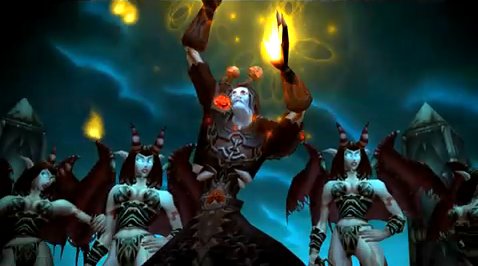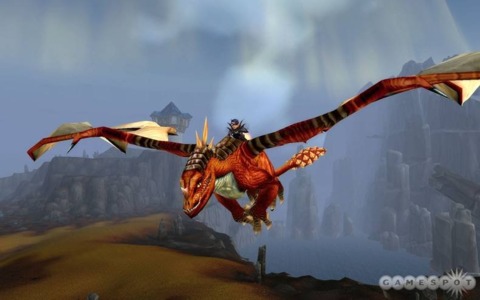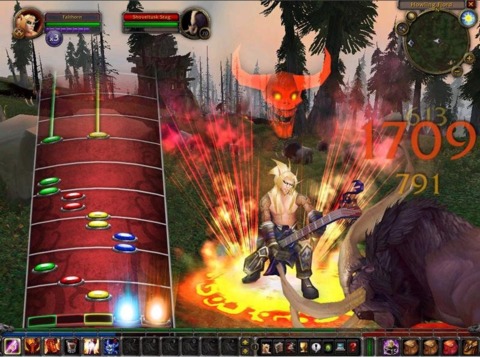Blizzard outlines massive effort behind World of Warcraft
Austin GDC 2009: Frank Pearce explains what it takes to craft 7,650 quests, 70,000 spells, 40,000 NPCs, 1.5 million assets, and 5.5 million lines of code; some 4,000 employees, 13,250 server blades, and 75,000 CPU cores keep MMORPG running.

Who Was There: Blizzard Entertainment cofounder and executive vice president of product development Frank Pearce and production director J. Allen Brack opened Thursday's schedule of panels with a keynote address titled "The Universe of World of Warcraft."
What They Talked About: In the GDC Austin schedule, Pearce and Brack's keynote address is described as offering "an in-depth at the operational complexities of running a large-scale MMO." While there has been no shortage of people to talk about the difficulties of developing and running MMORPGs, few have experience with anything as "large-scale" as World of Warcraft and its 11-million-strong subscriber base.

The biggest recurring theme of the at-times-technical presentation was "large-scale." Brack began by explaining the studio's layout, emphasizing that Blizzard tries to form its structure around the people, and not the other way around.
The programming team is responsible for updating and maintaining 5.5 million lines of code. The team of 51 artists has created 1.5 million unique assets for the game, with a handful of sub-teams dedicated to weapons and armor; environments; animation; props like torches or fence posts; dungeons and large objects like houses; and technical art to polish what everyone else creates. There are 37 designers responsible for creating classes, professions, events, a library of more than 70,000 spells, and a population of nearly 40,000 non-player characters.
Then there's an entire cinematics department of 123 people that does more than just cutscenes. Pearce said the team acts as reference when merchandising partners want to make replicas, or, say, gaudy 12-foot-tall statues like the one sitting outside Blizzard's headquarters.

There's also a QA testing team, which employs 218 people. That group's job gets tougher as time goes on, Brack said, because the amount of content in the game expands, but the size of the team does not. The original World of Warcraft contained 2,600 quests, with the Burning Crusade expansion adding another 2,700, and Wrath of the Lich King contributing another 2,350 to the game--a total of 7,650 in all. Also adding to the QA team's woes, Brack said, is that Blizzard promotes from within, taking some of the most talented QA testers out of the pool to work on other parts of the game.
As if there weren't enough to deal with, Pearce said Blizzard handles the localization of the game in-house. It's crucial for the game, since World of Warcraft is played in English by fewer than half the game's players. He added that the team doesn't do any partial localizations, and adding another language to the game is a commitment to provide ongoing support to that for as long as the game is running.

Patching is another problem, with many different versions of the game and previous patches out there for which compatibility must be assured. Brack said every time the company releases a patch, it needs to prepare more than 120 versions of it to make sure every player will get one compatible with his or her game.
Pearce talked about Blizzard Online Network Services, a group of 68 people who run data centers where servers are hosted in Washington, California, Texas, Massachusetts, France, Germany, Sweden, South Korea, China, and Taiwan. Between them, there are 13,250 server blades and 75,000 CPU cores keeping the World of Warcraft up and running.
Then there are international offices, which employ about 1,700 people across France, South Korea, Taiwan, China, and Ireland dealing with local concerns and customer service. Customer service is one of the biggest chunks of Blizzard, Brack said, with more than 2,500 people worldwide dedicated to the team.

The numbers don't stop: nearly 150 people on the team are responsible for Battle.net, from maintaining billing and the account system to creating the infrastructure that will let the 12 million active Battle.net players keep persistent friends lists across games when Starcraft II launches. There are also dedicated groups for public relations; a Web team for the game's slate of official Web sites; the community team serving as forum mods and liaison between developers and players; and a corporate applications team responsible for fraud detection and data mining on the World of Warcraft achievement system. Pearce dropped a little bit of info on that, noting that to date, World of Warcraft players have earned collectively about 4.5 billion achievements.
It's not over yet. Pearce talked about the eSports team, which has been involved in more than 1,600 tournaments around the world. They also act as a direct line of communication for feedback between the developers and the highest end of high-end players. Blizzard also needs an events team to put together BlizzCon, which Brack said is operated at a substantial loss for the company. While the company doesn't turn a profit on the annual shindig, Brack said the cost is worth it for marketing purposes.
Speaking of marketing, there's a World of Warcraft-specific team for that as well. They're responsible for TV commercials, promotions, and tie-ins like this summer's World of Warcraft-themed flavors of Mountain Dew. A separate licensing department handles board games, plushies, statues, novels, and anything else with the World of Warcraft logo on it.

World of Warcraft didn't start off this large, which means Blizzard has needed to establish a recruiting team as well. Blizzard is essentially always hiring, Brack and Pearce said, with 221 job openings worldwide at the moment.
There's a creative development team responsible for chronicling the lore of the series, working with licensing and novelists to ensure the World of Warcraft story is consistent across products. They don't create the lore, Brack said, but they do maintain it.
Wrapping up the presentation, the pair also gave quick shouts to their human resources, finance, facilities, legal, and information technology teams. In all, Blizzard has more than 4,000 employees and 600 licensed partners helping to keep the World of Warcraft turning.
Quote: "The moral of the story is that operating an online game is about more than just game development."--Frank Pearce
Takeaway: Clearly, running a massively multiplayer online game is a massive task indeed. As Pearce noted partway through the hour-long presentation, despite all the numbers thrown at the audience, the most mind-boggling may have been "one," the number of MMO games Blizzard is making in addition to World of Warcraft.
Fallout 4 Next Gen Update Comparison Fallout 4 Steam Deck Verified Gameplay ALIEN: Rogue Incursion - Announcement Teaser Trailer Stellar Blade - 13 Things I Wish I Knew S.T.A.L.K.E.R. 2: Heart of Chornobyl — Official "Not a Paradise" Trailer Sea of Thieves Season 12: Official Content Update Video Why Are Video Game Adaptations Good Now? | Spot On Manor Lords - Official Medieval City Builder/RTS Launch Trailer Honkai: Star Rail - "Then Wake to Weep" | Version 2.2 Trailer Devil May Cry: Peak Of Combat | Dante: Blazing Tempest Gameplay Trailer SAND LAND — Official Launch Trailer Stellar Blade - Hard Mode No Damage Gigas Boss Gameplay
Please enter your date of birth to view this video
By clicking 'enter', you agree to GameSpot's
Terms of Use and Privacy Policy
Got a news tip or want to contact us directly? Email news@gamespot.com
Join the conversation